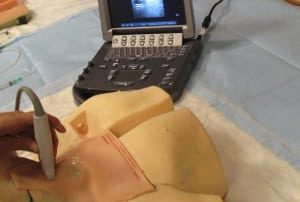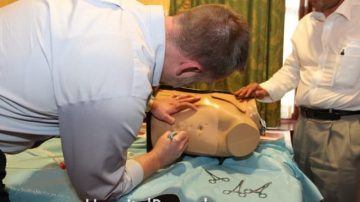Point-of-care ultrasound is one of the most rapidly evolving areas of medicine. In addition to becoming the “stethoscope of the future” for bedside diagnostic evaluations, ultrasound has improved the safety and efficiency of a wide range of procedures. The use…
Read MoreEmergency department (ED) intubation is constantly evolving, with new devices, techniques, and medications being frequently adopted. To evaluate temporal trends, National Emergency Airway Registry (NEAR) investigators analyzed registry data on ED intubations at 13 large hospitals in the U.S., Canada,…
Read MoreTraditional teaching is that chest tubes placed to evacuate a pneumothorax should be directed anterior and superior and to evacuate fluid should be directed posterior and inferior. A recent study examined the effect of specific chest tube position on chest…
Read MoreMore Articles – Cardiovascular diseases, Chest Tube, Emergency Procedures, Featured, medical procedures
The optimal insertion site for tube thoracostomy is at the mid-axillary line in the triangle of safety. This avoids any major nerves or arteries aside from the intercostal vessels. Ultrasound-guided localization of this site performed better than palpation. In semi-elective…
Read MorePatients may have anatomically difficult airways or physiologically difficult airways. Both anatomical and physiological factors can lead to peri-intubation complications. My goal for this blog is to describe the factors that may contribute to an anatomically difficult airway and clinical…
Read MoreThe evidence base for the safety of ultrasound-guided central line placement with thrombocytopenia or in patients with a bleeding diathesis is not robust. Nevertheless, based on the data available most procedural experts feels that an ultrasound-guided central venous catheter insertion…
Read MoreOver the past several years, there has been a dramatic increase in the use of the new oral anticoagulants (Dabigatran, Rivaroxaban, and Apixaban). The popularity of these medications stems not only from aggressive pharmaceutical monitoring to physicians and to the…
Read MoreTraditionally, it has been promulgated by anesthesiologists that you need a platelet count of 100,000 to safely perform neuraxial regional anesthesia (spinal and epidural anesthesia). This practice pattern has continued even though Children’s Hospitals routinely perform intrathecal injections for prophylactic chemotherapy with…
Read MoreDiagnostic lumbar punctures aid in the diagnosis of infections and diseases of the central nervous system. Life-threatening events from lumbar punctures are rare, but post–lumbar (dural) puncture headaches (PDPH) occur in 1% to 36% of patients, depending on the needle…
Read MoreMore Articles – Central line, Featured Procedure, medical procedures, Ultrasound-Guided Peripheral IV
Safety checklists have been adopted by numerous industries to prevent errors and save lives. Checklists have been used for decades by industries as diverse as the aviation industry, construction companies, and professional chefs to prevent mistakes. In medicine, checklists have…
Read MoreMore Articles – Cardiovascular diseases, Featured, Hospital Procedures, Medical General, medical procedures
Medications Alpha Beta1 Beta2 Dopamine V1 V2 Norepinephrine …
Read MoreHistorically, it was felt that a platelet count below 50,000 or an INR>1.5 was a contraindication to thoracentesis because of an increased bleeding risk. These were arbitrary cut-offs that have since been challenged with newer kits and the use of…
Read MoreRemember the Laryngeal Mask Airway When You Can’t Intubate! As a hospitalist who also works in the ICU, I am often the first responder to respiratory emergencies. Frequently under these circumstances, you have a chaotic environment and a less than…
Read MoreThe 2018 AHA/ASA guidelines for the early management of acute ischemic stroke provides some important new evidence-based recommendations. Some important new recommendations described in these guidelines include: The DAWN and DEFUSE 3 trials selected patients for mechanical thrombectomy within an extended time…
Read MoreRapid Ultrasonography in Shock: Is this really useful? Caring for patients with undifferentiated hypotension, causes anxiety for most health care providers. This is natural. Fear, however, must not lead to hesitation or poor decision-making. Therapies chosen early in shock disproportionately…
Read MoreCategories
- ACLS (1)
- Arterial line (33)
- Cardiovascular diseases (77)
- Central line (55)
- Chest Tube (39)
- Dermatology (4)
- Emergency Procedures (139)
- Endocrinology (6)
- Endotracheal Intubation (36)
- Events (24)
- FAST Exam (12)
- Featured (113)
- Featured Procedure (42)
- Gastrointestinal diseases (32)
- Ginecology (3)
- Glidescope Intubation (21)
- Hematology (33)
- Hospital Procedures (85)
- Infections (32)
- Intraosseous line (8)
- King Tube (27)
- Laryngeal Mask Airway (18)
- Lumbar Puncture (36)
- Mechanical Ventilation (34)
- Medical General (95)
- medical procedures (258)
- Needle Decompression (6)
- Nephrology (11)
- Neurological diseases (12)
- Oncology (4)
- Paracentesis (32)
- Pericardiocentesis (3)
- Procedural Sedation (19)
- Respiratory diseases (85)
- RUSH Exam (8)
- Thoracentesis (37)
- Traumatology (24)
- Travel (27)
- Ultrasound-Guided Peripheral IV (13)












